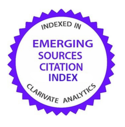Big-data analytics en seguros
DOI:
https://doi.org/10.26360/2017_1Palabras clave:
Big-data, seguros, modelización, análisis de datos, líneas de negocio, curva ROCResumen
La revolución del big-data ha impactado en el sector asegurador más de lo que se esperaba, hasta convertirse en un ejemplo paradigmático de lo que es la nueva economía digital. La gran cantidad de datos y la modelización predictiva en seguros representan un punto de inflexión y una oportunidad de oro para canalizar la teoría del riesgo hacia la predicción de las pérdidas. Los cambios son radicales y demandan transformaciones profundas a nivel organizacional. En este trabajo presentamos algunas reflexiones sobre lo que supone la incorporación del Analytics en una compañía de seguros y mostramos su inherente complejidad mediante un caso ya testado con éxito.
Descargas
Citas
Bolancé, C., Guillen, M. y A. E. Padilla-Barreto (2016). Predicting detection in non-life motor and home insurance. Lectures on Modeling and Simulation 2, 107-120.
Boser, B. E., Guyon, I. M. y V. N. Vapnik (1992). A training algorithm for optimal margin classifiers. Proceedings of the fifth annual workshop on Computational Learning Theory, 144-152.
Dobbin, K. K. y R. M. Simon (2011). Optimally splitting cases for training and testing high dimensional classifiers. BMC Medical Genomics 4, 31, 1-8.
Guelman, L., Guillen, M. y A. M. Pérez-Marín (2014). A survey of personalized treatment models for pricing strategies in insurance. Insurance: Mathematics and Economics, 58, 68-76.
Guillen, M. (2016). Big data en seguros. Índice: revista de estadística y sociedad 67, 28-30.
Harrington, E. (2014). Building an analytics team for your organization part I. http://iianalytics.com/research/building-an-analytics-team-for-your-organization-part-i (7 de julio de 2017).
Hastie, T. (1998). Neural network. En Encyclopedia of Biostatistics, P. Armitage y T. Colton (eds.), John Wiley & Sons, Ltd, New York, 2986-2989.
Hornik, K., Meyer, D. y A. Karatzoglou (2006). Support vector machines in R. Journal of Statistical Software 15(9), 1-28.
Hothorn, T., Hornik, K. y A. Zeileis (2006). Unbiased recursive partitioning: A conditional inference framework. Journal of Computational and Graphical Statistics 15(3), 651-674.
Livingstone, D. J., Manallack, D. T. y I. V. Tetko (1997). Data modelling with neural networks: advantages and limitations. Journal of computer- aided molecular design 11(2), 135-142.
Myatt, G. J. (2007). Making sense of data: a practical guide to exploratory data analysis and data mining. John Wiley & Sons. New York.
McAfee, A. y E. Brynjolfsson (2012). Big data: the management revolution. Harvard Business Review 90(10), 60-68.
McCullagh, P. y J. A. Nelder (1989). Generalized linear models, 37. CRC press.
Meyer, D. y F. T. Wien (2001). Support vector machines. R News 1(3), 23-26.
Meyer, D., Dimitriadou, E., Hornik, L., Weingessel, A., Leisch, F. y C. C. Chang (2012). Package e1071: Misc functions of the department of statistics (e1071), TU Wien. R package version, 1-6.
Russom, P. (2011). Big data analytics. TDWI Best practices report, Fourth quarter 19, 40.
Suykens, J. A. y J. Vandewalle (1999). Least squares support vector machine classifiers. Neural Processing Letters 9(3), 293-300.
Swedloff, R. (2014). Risk classification's big data (r) evolution. Connecticut Insurance Law Journal 21, 339-374.
Tu, J. V. (1996). Advantages and disadvantages of using artificial neural networks versus logistic regression for predicting medical outcomes. Journal of clinical epidemiology 49(11), 1225-1231.
Descargas
Publicado
Cómo citar
Número
Sección
Licencia
Derechos de autor 2023 Alemar E. Padilla-Barreto, Montserrat Guillen, Catalina Bolancé

Esta obra está bajo una licencia internacional Creative Commons Atribución-NoComercial-SinDerivadas 4.0.


















